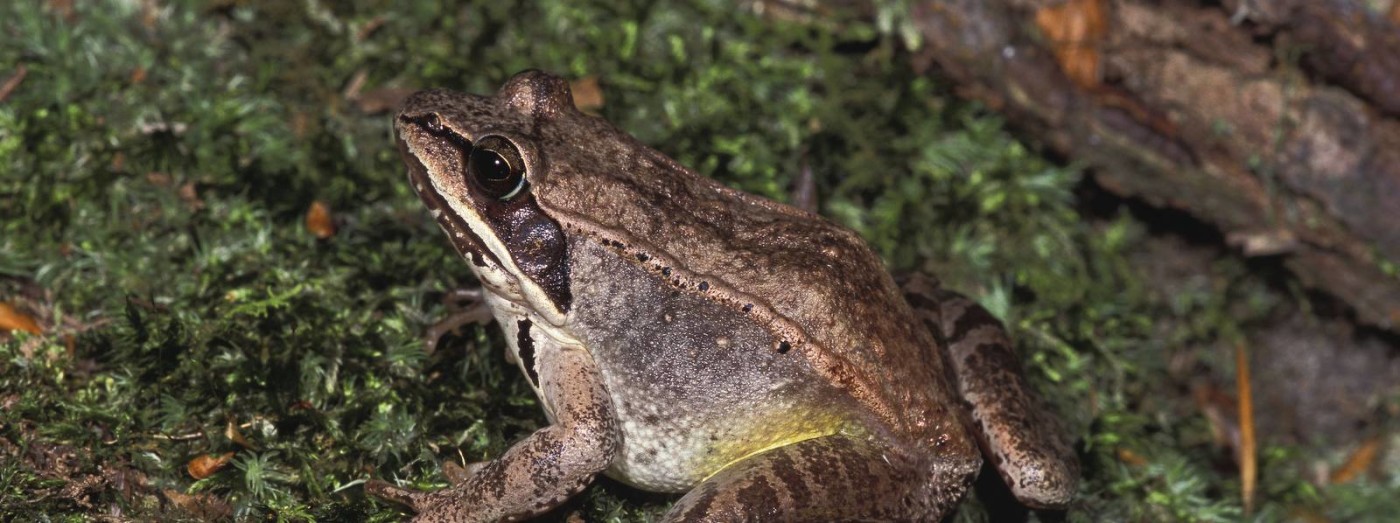Animals and Plants of the Finger Lakes
Lazarus of the Amphibian World
Winter is a hard time, particularly for those animals that cannot regulate their body temperatures.
It is perhaps hardest for amphibians, whose moist skins make them susceptible to freezing. Many aquatic frogs, such as the bullfrog and leopard frog, lie dormant all winter below the ice, breathing through their skins. Terrestrial animals are exposed to far more extreme temperatures. Those that can’t avoid freezing temperatures have two ways of making it through the winter: freeze resistance and freeze tolerance.

Freeze-resistant animals rely on a phenomenon known as supercooling. Despite what we’ve all learned, water doesn’t necessarily freeze at 0 °C. A small volume of very pure and still water can stay liquid to −42 °C; however, the moment this supercooled water contacts an ice crystal, it will freeze solid almost instantly. Smaller animals, including some insects and reptiles, use supercooling to weather brief and relatively mild freezing episodes. Most amphibians cannot use this technique, however, because their skins are highly permeable to water and ice.
The wood frog (Rana sylvatica) is one of a handful of North American frogs that is freeze-tolerant. If you search very carefully under the leaf-fall on the upland forest floor, you’re likely to find one of these little black-masked fellows sitting motionlessly, perfectly camouflaged, limbs neatly tucked into its body in order to reduce water loss. It will remain there all winter, freezing and thawing along with the soil itself, until spring finally frees it from its state of suspended animation.
Frostbite occurs when ice crystals form within tissues and slice like knives through delicate cell structures, causing irreparable damage. In order for the wood frog to survive winter, it must ensure that the water in its cells does not turn to ice. When the frog first begins to freeze, it saturates its body with glucose. Water that contains dissolved solutes (such as salts or sugars) freezes at a lower temperature than does pure water, which is why icebergs float in the ocean. In the same way, glucose acts as a cryoprotectant, a sort of “antifreeze” that lowers the freezing point of the frog. This little animal is remarkably tough, but it is not invincible: it cannot survive if more than about 65 percent of the water in its body freezes.

As the frog cools further, ice forms in the blood and lymph vessels and the gut, where it can do no damage. The more water that is locked up in ice, the greater the concentration of solutes in the blood and lymph, and the more water that is drawn out from the cells. (Something similar happens when you rub a piece of meat with salt in order to draw out the juices.) The cells shrink but do not collapse because they contain glucose, which reduces water outflow. The tiny amount of water in each dehydrated cell then supercools so that the cell contents remain liquid even when the temperature drops considerably below freezing.
Wood frogs also accumulate the chemical urea in their tissues when they are subjected to dry conditions, such as those of late fall and early winter. Urea minimizes the amount of water that is lost through the skin. It seems to be an even more effective cryoprotectant than glucose and also has a depressant effect on the frog’s metabolism. Both glucose and urea seem to stabilize cell structures and protect them from being damaged by freezing, although no one yet knows how this works.
When the temperature warms, the frog begins to defrost in the opposite direction that it froze: that is, from the inside out. It is in the center of the frog that blood last circulated and the glucose concentration is highest, and therefore where the melting point is lowest. The heart, which had been encased in ice, begins beating again; the shrunken vital organs and muscles rehydrate and resume functioning after a few hours. If it is spring, and not just a brief thaw (and the frogs seem to know which is which), they will mate just a few days later. Their resurrection is perfectly timed: the warmer weather brings rain to fill the vernal pools in which they will lay their eggs.
This story by Jacqueline Stuhmiller first appeared in our newsletter, The Land Steward, as part of the Closer Look series about plants and animals of the Finger Lakes region.





